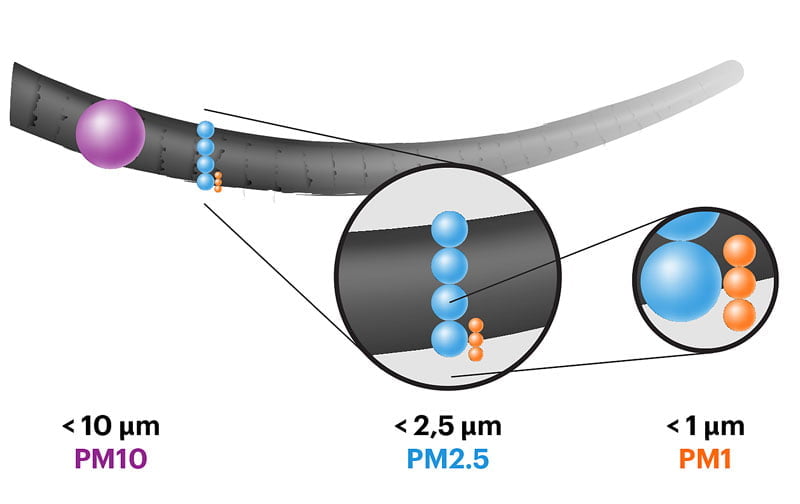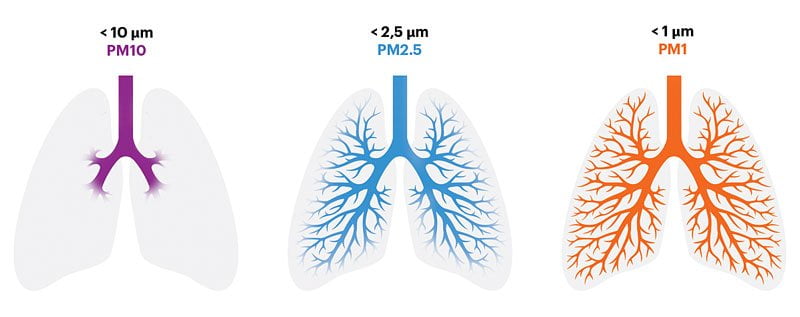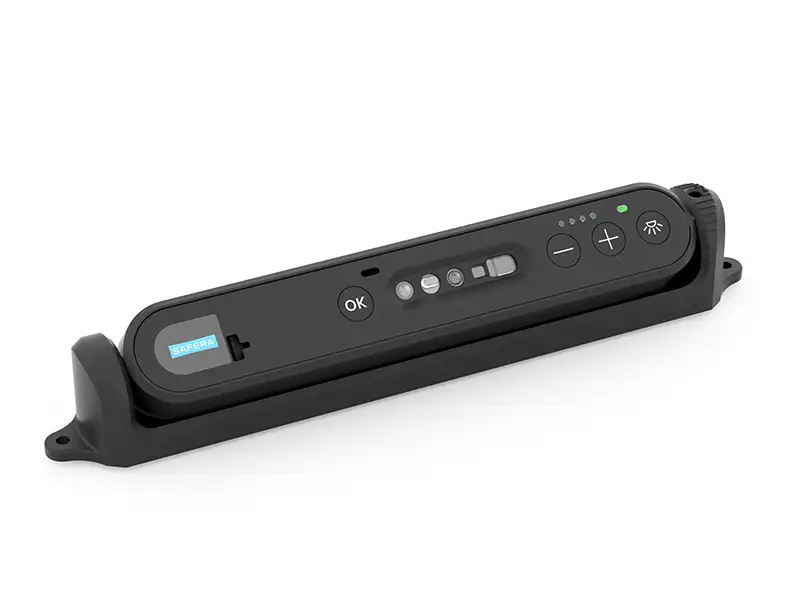Fine particles PM2.5 have a significant impact on health – Safera’s sensor system measures fine particles reliably
Air pollution, including fine particulate matter PM2.5, is the largest environmental health risk in Europe according to European Environment Agency EEA.
Air pollution significantly impacts the health particularly in urban areas, where 96% of the population was exposed to levels of PM2.5 above the guidelines of WHO, the World Health Organization.
In the past, expensive measuring devices were needed to reliably measure fine particles, but the Finnish company Safera has developed a new low cost solution for the reliable measurement and data analysis of fine particulate matter.
Fine particles are invisible air pollution harmful to health
Particles are divided into two categories based on how deeply particles of different sizes penetrate into the human respiratory system and body:
- Inhalable particles, i.e. PM10 particles
- Fine particles, i.e. PM2.5 particles
Particles with a maximum diameter of 10 micrometers are called respirable particles or PM10 particles. The largest of these inhaled particles are likely to remain in the pharynx and upper parts of the lungs, so they are removed with the creation of mucus. They cause, among other things, irritation in the upper respiratory tract.
In terms of health, particles with a size of 2.5 micrometers or less are more dangerous. They get deeper into the lungs. These particularly harmful particles are called fine particles or PM2.5 particles. Fine particles reach all parts of the lungs and do not leave the lungs with mucus like larger particles.
The smallest of the fine particles, i.e. PM1 particles (maximum diameter of 1 micrometer) can also enter the bloodstream from the lungs.


When a person breathes in fine particles, they penetrate into the alveoli and are harmful to health. In particular, the small size of the particles and their ability to penetrate deep into the body causes health problems, regardless of the substance of the fine particles.
It should be noted that when the PM10 concentration is reported, it also includes the amount of smaller particles, i.e. PM2.5 and PM1. Similarly, the PM2.5 reading also includes the amount of PM1 particles. When evaluating the health effects of air quality, it is important that the measuring device is able to measure particles of different sizes and report the reading correctly, regardless of the distribution of particles of different sizes in the air.


There is no safe limit for fine particles
Fine particles are an invisible health hazard, and their effect on health has been studied a lot.
Particles can cause shortness of breath, for example, and especially asthmatics and people with heart and respiratory illnesses can get serious symptoms. Fine particles can also cause lung cancer.
According to the new recommendations from WHO, exposure to the concentrations of PM2.5 fine particles should be less than 5 μg/m 3 as an annual average, and less than 15 μg/m 3 as a 24-hour average.
However, a safe limit for fine particles has not been determined, but they are always a health risk.
Fine particles are produced from several sources. Fine particles are almost everywhere both indoors and outdoors, so it’s hard not to breathe them in. That’s why it’s important to know how many fine particles there are in the air you breathe and how you can reduce their formation through your own actions.
“Air pollution is the largest environmental health risk in Europe. It is a major cause of adverse health effects: for instance, air pollution causes and aggravates respiratory and cardiovascular diseases. Heart disease and stroke are the most common causes of premature deaths attributable to air pollution, followed by lung diseases and lung cancer..”
EEA: Air quality in Europe 2024
- 96% of the EU’s urban population is exposed to unsafe concentrations of fine particulate matter (PM2.5).
- The European Green Deal’s zero pollution plan aims to reduce premature deaths from PM2.5 by at least 55% by 2030 compared to 2005 levels. The ultimate goal is for air pollution to have no major health impacts by 2050.
- Co-legislators agreed to more ambitious EU air quality standards in February 2024.
Source: European Environment Agency
WHO: Ambient (outdoor) air pollution
- Air pollution is one of the greatest environmental risks to child health
- In 2019, 99% of the world’s population was living in places where the WHO air quality guidelines levels were not met.
Source: WHO
Air quality in Europe 2022
- Air pollution is a major health concern for Europeans.
- In 2020 in the EU, 96% of the people living in the urban areas was exposed to PM2.5 levels above the recommendation set by the World Health Organization.
- Fine particulate matter concentrations higher than WHO recommendation resulted in 238,000 premature deaths in the European Union.
- Compared to year 2005, the target is to reduce the number of premature deaths due to exposure to fine particulate matter by 55% by 2030. In 2020, premature deaths had fell by 45% compared to year 2005.
Source: European Environment Agency
Many devices measure fine particles incorrectly – the most dangerous, i.e. the smallest particles are not detected
Many ventilation systems used in buildings today already contain fine particle sensors, but there can be large differences in their quality. Many inexpensive sensors do not provide reliable information on the amount of fine particles in the breathing air.
Such sensors are often designed to measure only the largest fine particles, after which they estimate the amount of the smallest particles likely to be in the breathing air.
A problem arises if there are mainly the smallest particles in the air; in this case the sensor is not able to identify a potential danger. The smallest of the fine particles, i.e. PM1 particles, which are the most dangerous for health, can be completely invisible to many sensors. The sensors believe the air is cleaner than it really is.
Safera’s PM2.5 sensors are designed to directly measure PM1 particles as well, so that they can produce a reliable result on air quality, regardless of the distribution of particles of different sizes in the air.
Often, reliable data collection also requires that the sensors’ electronics and their algorithms be adjusted according to the device’s intended use and environment. This is not possible with universal particle sensors. With the sensor system developed by Safera and the agile development environment, the sensors can be adjusted and customised easily and quickly according to the application target. The end result are durable, accurate and reliable measuring devices for different needs.
Practical examples of applying algorithms to different usage situations:
- The customised algorithm in cooker hoods takes into account in particular special situations caused by cooking, such as huge fluctuations in humidity percentage and changes in air flow, which can cause great inaccuracy in generic sensor modules.
- At construction sites and renovation sites, custom pre-filtering combined with custom algorithms improves sensor module lifetime and accuracy in extremely dirty conditions.
More durable fine particle sensors with the help of a pre-filter
Safera has experience in the use of fine particle sensors in challenging environments.
Safera’s sensors have been integrated in cooker hoods, for example, where the sensors must be mechanically protected from dirt and grease. To meet this need, we have developed pre-filtration solutions that are designed to be exceptionally resistant to dirt.
Many sensor suppliers are not able to offer pre-filtering for the sensors, because the ready-made algorithms are not able to take into account its effect on the measurement results. In difficult conditions, such sensors get dirty and break quickly.
Reliable data collection using pre-filtering requires experience and attention to many details. Pre-filtering must be implemented so that it does not affect the measurement results of the sensors. The sensors’ artificial intelligence algorithms must be taught to take the slow contamination during the life cycle of the pre-filter into account, for example.
Spaces where the humidity percentage varies and the air moves quickly can also be challenging for sensors that measure fine particles. Even in these cases, however, we can teach the algorithms to take into account the effects of these conditions on the measurement.
Safera AQ Monitor PM2.5 is now available for order in EU
You can now order the Safera AQ Monitor PM2.5 from us at 299,00 EUR (incl. VAT 25.5%). Free delivery. The stand-alone, mains-powered monitor can be used indoors or outdoors and connects to the Safera Cloud for air quality data logging (API available).
Specifications
- Measures: PM2.5 (proprietary sensor), TVOC, Temperature, Humidity, eCO2
- Free Safera Cloud with API
- Free Safera App for AQ Monitor control and live results
- Bluetooth 5.0
- Wi-Fi 802.11 b/g/n
- 230V mains-powered
- Available in EU


Are you interested in measuring fine particles?
With Safera’s patented sensors, even the smallest fine particles can be reliably measured, and the sensors’ immunity to interference even in challenging environments has been improved.
Effective measurement and prevention of fine particles can be a clear competitive advantage for equipment manufacturers. Would you like to hear more about its possibilities? Book a meeting with our experts.
See also:
FlowHero helped our customer win the Energy Genius of the Year award
Real estate investor Areim has won the prestigious Energy Genius of the Year 2024 award by successfully halving the energy consumption of ventilation in its
FlowHero Case Study: Mandatum Niittytaival 13
In Mandatum’s office building, the kitchen ventilation was a compromise between energy efficiency and indoor air quality. It was upgraded to FlowHero’s demand control ventilation,
